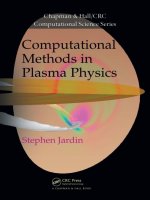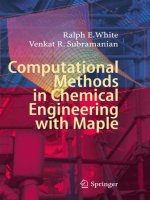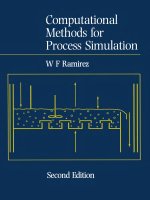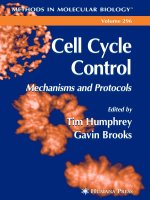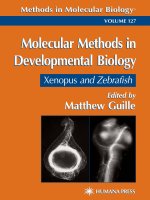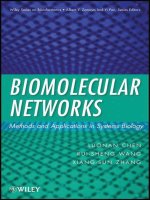Computational methods in systems biology 14th international conference, CMSB 2016
Bạn đang xem bản rút gọn của tài liệu. Xem và tải ngay bản đầy đủ của tài liệu tại đây (19.32 MB, 361 trang )
LNBI 9859
Ezio Bartocci · Pietro Lio
Nicola Paoletti (Eds.)
Computational Methods
in Systems Biology
14th International Conference, CMSB 2016
Cambridge, UK, September 21–23, 2016
Proceedings
123
Lecture Notes in Bioinformatics
9859
Subseries of Lecture Notes in Computer Science
LNBI Series Editors
Sorin Istrail
Brown University, Providence, RI, USA
Pavel Pevzner
University of California, San Diego, CA, USA
Michael Waterman
University of Southern California, Los Angeles, CA, USA
LNBI Editorial Board
Søren Brunak
Technical University of Denmark, Kongens Lyngby, Denmark
Mikhail S. Gelfand
IITP, Research and Training Center on Bioinformatics, Moscow, Russia
Thomas Lengauer
Max Planck Institute for Informatics, Saarbrücken, Germany
Satoru Miyano
University of Tokyo, Tokyo, Japan
Eugene Myers
Max Planck Institute of Molecular Cell Biology and Genetics, Dresden,
Germany
Marie-France Sagot
Université Lyon 1, Villeurbanne, France
David Sankoff
University of Ottawa, Ottawa, Canada
Ron Shamir
Tel Aviv University, Ramat Aviv, Tel Aviv, Israel
Terry Speed
Walter and Eliza Hall Institute of Medical Research, Melbourne, VIC, Australia
Martin Vingron
Max Planck Institute for Molecular Genetics, Berlin, Germany
W. Eric Wong
University of Texas at Dallas, Richardson, TX, USA
More information about this series at />
Ezio Bartocci Pietro Lio
Nicola Paoletti (Eds.)
•
Computational Methods
in Systems Biology
14th International Conference, CMSB 2016
Cambridge, UK, September 21–23, 2016
Proceedings
123
Editors
Ezio Bartocci
TU Wien
Vienna
Austria
Nicola Paoletti
Department of Computer Science
University of Oxford
Oxford
UK
Pietro Lio
Computer Laboratory
University of Cambridge
Cambridge
UK
ISSN 0302-9743
Lecture Notes in Bioinformatics
ISBN 978-3-319-45176-3
DOI 10.1007/978-3-319-45177-0
ISSN 1611-3349
(electronic)
ISBN 978-3-319-45177-0
(eBook)
Library of Congress Control Number: 2016948626
LNCS Sublibrary: SL8 – Bioinformatics
© Springer International Publishing AG 2016
This work is subject to copyright. All rights are reserved by the Publisher, whether the whole or part of the
material is concerned, specifically the rights of translation, reprinting, reuse of illustrations, recitation,
broadcasting, reproduction on microfilms or in any other physical way, and transmission or information
storage and retrieval, electronic adaptation, computer software, or by similar or dissimilar methodology now
known or hereafter developed.
The use of general descriptive names, registered names, trademarks, service marks, etc. in this publication
does not imply, even in the absence of a specific statement, that such names are exempt from the relevant
protective laws and regulations and therefore free for general use.
The publisher, the authors and the editors are safe to assume that the advice and information in this book are
believed to be true and accurate at the date of publication. Neither the publisher nor the authors or the editors
give a warranty, express or implied, with respect to the material contained herein or for any errors or
omissions that may have been made.
Printed on acid-free paper
This Springer imprint is published by Springer Nature
The registered company is Springer International Publishing AG
The registered company address is: Gewerbestrasse 11, 6330 Cham, Switzerland
Preface
This volume contains the papers presented at CMSB 2016, the 14th Conference on
Computational Methods in Systems Biology, held on September 21–23, 2016 at the
Computer Laboratory, University of Cambridge (UK).
The CMSB annual conference series, initiated in 2003, provides a unique forum of
discussion for computer scientists, biologists, mathematicians, engineers, and physicists interested in a system-level understanding of biological processes. Topics of
interest include formalisms for modelling biological processes; models and their biological applications; frameworks for model verification, validation, analysis, and
simulation of biological systems; high-performance computational systems biology and
parallel implementations; model inference from experimental data; model integration
from biological databases; multi-scale modelling and analysis methods; and computational approaches for synthetic biology. Case studies in systems and synthetic biology
are especially encouraged.
There were 37 regular submissions, 3 tools papers, and 9 poster submissions. Each
regular submission and tool paper submission was reviewed by at least 4 Program
Committee members. The committee decided to accept 17 regular papers, 3 tool
papers, and all submitted posters. On average, regular and tool papers received 4.2
reviews each, while each poster submissions received 2 reviews. To complement the
contributed papers, we also included in the program four invited lectures: Luca Cardelli
(Microsoft Research, UK), Joëlle Despeyroux (Inria Sophia Antipolis, France), Radu
Grosu (TU Wien, Austria), and Jane Hillston (University of Edinburgh, UK).
As program co-chairs, we have many people to thank. We are extremely grateful to
the members of the Program Committee and the external reviewers for their peer
reviews and the valuable feedback they provided to the authors. We thank also the
authors of the accepted papers for revising the papers according to the suggestions
of the program committee and for their responsiveness on providing the camera-ready
copies within the deadline. Our special thanks goes to François Fages and all the
members of the CMSB Steering Committee for their advice on organizing and running
the conference. We acknowledge the support of the EasyChair conference system
during the reviewing process and the production of these proceedings. We thank
Kaushik Chowdhury and the IEEE Computer Society Technical Committee on Simulation for supporting the best student paper award and the best poster award. We thank
NVIDIA for providing their equipment as the best paper award. Our gratitude also goes
to the tool track chair, Claudio Angione, and the local organization chair, Max Conway, for their help, support, and spirited participation before, during, and after the
conference. We are also really grateful to Paolo Zuliani for having organized a minisymposium on Automated Reasoning for Systems Biology, which was held a day
before the conference. It is our pleasant duty to acknowledge the financial support from
our sponsor, Microsoft Research, and the support of the Computer Laboratory at the
University of Cambridge, where this year’s event was hosted. Finally, we would like to
VI
Preface
thank all the participants of the conference. It was the quality of their presentations and
their contribution to the discussions that made the meeting a scientific success.
September 2016
Ezio Bartocci
Pietro Lio
Nicola Paoletti
Organization
Program Committee Co-chairs
Ezio Bartocci
Pietro Lio
Nicola Paoletti
TU Wien, Austria
University of Cambridge, UK
Oxford University, UK
Tools Track Chair
Claudio Angione
Teesside University, UK
Local Organization Chair
Max Conway
University of Cambridge, UK
Program Committee
Claudio Angione
Gianluca Ascolani
Julio Banga
Ezio Bartocci
Gregory Batt
Luca Bortolussi
Jérémie Bourdon
Andrea Bracciali
Luca Cardelli
Milan Češka
Vincent Danos
Joëlle Despeyroux
Diego Di Bernardo
François Fages
Flavio H. Fenton
Jérôme Feret
Calin Guet
Monika Heiner
Lila Kari
Heinz Köppl
Hillel Kugler
Marta Kwiatkowska
Pietro Lio
Teesside University, UK
University of Cambridge, UK
IIM-CSIC, Spain
TU Wien, Austria
Inria Paris-Rocquencourt, France
University of Trieste, Italy
Nantes University, France
University of Stirling, UK
Microsoft Research, UK
Oxford University, UK
University of Edinburgh, UK
Inria Sophia Antipolis, France
University of Naples Federico II, Italy
Inria Paris-Rocquencourt, France
Georgia Tech, USA
Inria/Ecole Normale Supérieure, France
IST Austria
Brandenburg University of Technology, Germany
University of Western Ontario, Canada
TU Darmstadt, Germany
Bar-Ilan University, Israel
University of Oxford, UK
University of Cambridge, UK
VIII
Organization
Oded Maler
Giancarlo Mauri
Pedro Mendes
Nicola Paoletti
Tatjana Petrov
Andrew Phillips
Carla Piazza
Ovidiu Radulescu
Blanca Rodriguez
Olivier Roux
David Šafránek
Guido Sanguinetti
Scott A. Smolka
Oliver Stegle
Jörg Stelling
Carolyn Talcott
P.S. Thiagarajan
Adelinde Uhrmacher
Verena Wolf
Boyan Yordanov
Paolo Zuliani
CNRS-VERIMAG, France
University of Milano Bicocca, Italy
University of Manchester, UK/University of Connecticut
Health Center, USA
University of Oxford, UK
IST Austria
Microsoft Research Cambridge, UK
University of Udine, Italy
University of Montpellier 2, France
University of Oxford, UK
École Centrale de Nantes, France
Masaryk University, Czech Republic
University of Edinburgh, UK
Stony Brook University, USA
EBI, UK
ETH Zurich, Switzerland
SRI International, USA
National University of Singapore, Singapore
University of Rostock, Germany
Saarland University, Germany
Microsoft Research Cambridge, UK
Newcastle University, UK
Tool Evaluation Committee
Claudio Angione
Liu Bing
Pierre Boutillier
Giulio Caravagna
Tommaso Dreossi
Maxime Folschette
Fabian Fröhlich
Attila Gabot
Emanuel Goncalves
Benjamin Gyori
Ariful Islam
Luca Laurenti
Curtis Madsen
Dimitrios Milios
Niall Murphy
Abhishek Murthy
Aurélien Naldi
Rasmus Petersen
Ly Kim Quyen
Giselle Reis
Satya Swarup Samal
Teesside University, UK
Carnegie Mellon University, USA
Harvard Medical School, USA
University of Edinburgh, UK
UC Berkeley, USA
University of Nice Sophia-Antipolis, France
Helmholtz Zentrum München, Germany
Aachen University, Germany
EBI, UK
Harvard Medical School, USA
Carnegie Mellon University, USA
University of Oxford, UK
Boston University, USA
University of Edinburgh, UK
Microsoft Research Cambridge, UK
Philips Research, USA
Université de Montpellier, France
Queen Mary University of London, UK
Ecole Normale Supérieure, France
Inria-Saclay, France
University of Bonn, Germany
Organization
Fedor Shmarov
Elisabeth Yaneske
IX
Newcastle University, UK
Teesside University, UK
Steering Committee
Jộrộmie Bourdon
Finn Drablos
Franỗois Fages
David Harel
Monika Heiner
Tommaso Mazza
Pedro Mendes
Satoru Miyano
Gordon Plotkin
Corrado Priami
Olivier Roux
Carolyn Talcott
Adelinde Uhrmacher
Nantes University, France
NTNU, Norway
Inria Paris-Rocquencourt, France
Weizmann Institute of Science, Israel
Brandenburg University of Technology, Germany
IRCCS Casa Sollievo della Sofferenza - Mendel, Italy
University of Manchester, UK/University of Connecticut
Health Center, USA
University of Tokyo, Japan
University of Edinburgh, UK
CoSBi/Microsoft Research, University of Trento, Italy
ẫcole Centrale de Nantes, France
SRI International, USA
University of Rostock, Germany
Additional Reviewers
Ahmad, Jamil
Asarin, Eugene
Barbot, Benoit
Beica, Andreea
Bueno-Orovio, Alfonso
Casagrande, Alberto
ervený, Jan
Cinquemani, Eugenio
Daca, Przemyslaw
Dannenberg, Frits
Eyassu, Filmon
Forets, Marcelo
Frọnzle, Martin
Galpin, Vashti
Gilbert, David
Herajy, Mostafa
Islam, Md. Ariful
Krivine, Jean
Kyriakopoulos,
Charalampos
Lỹck, Alexander
Magnin, Morgan
Magron, Victor
Niehren, Joachim
Nobile, Marco
Patanố, Andrea
Paulevộ, Loùc
Ramanathan, S.
Rohr, Christian
Ruet, Paul
Schnoerr, David
Soliman, Sylvain
Srivastav, Abhinav
Tschaikowski, Max
Contents
Invited Paper
(Mathematical) Logic for Systems Biology (Invited Paper) . . . . . . . . . . . . . .
Joëlle Despeyroux
3
Regular Papers
Generalized Method of Moments for Stochastic Reaction Networks
in Equilibrium . . . . . . . . . . . . . . . . . . . . . . . . . . . . . . . . . . . . . . . . . . . .
Michael Backenköhler, Luca Bortolussi, and Verena Wolf
Inference of Delayed Biological Regulatory Networks from Time
Series Data. . . . . . . . . . . . . . . . . . . . . . . . . . . . . . . . . . . . . . . . . . . . . . .
Emna Ben Abdallah, Tony Ribeiro, Morgan Magnin, Olivier Roux,
and Katsumi Inoue
15
30
Matching Models Across Abstraction Levels with Gaussian Processes . . . . . .
Giulio Caravagna, Luca Bortolussi, and Guido Sanguinetti
49
Target Controllability of Linear Networks . . . . . . . . . . . . . . . . . . . . . . . . .
Eugen Czeizler, Cristian Gratie, Wu Kai Chiu, Krishna Kanhaiya,
and Ion Petre
67
High-Performance Symbolic Parameter Synthesis of Biological Models:
A Case Study . . . . . . . . . . . . . . . . . . . . . . . . . . . . . . . . . . . . . . . . . . . . .
Martin Demko, Nikola Beneš, Luboš Brim, Samuel Pastva,
and David Šafránek
Influence Systems vs Reaction Systems . . . . . . . . . . . . . . . . . . . . . . . . . . .
François Fages, Thierry Martinez, David A. Rosenblueth,
and Sylvain Soliman
Local Traces: An Over-Approximation of the Behaviour of the Proteins
in Rule-Based Models . . . . . . . . . . . . . . . . . . . . . . . . . . . . . . . . . . . . . . .
Jérôme Feret and Kim Quyên Lý
Bifurcation Analysis of Cardiac Alternans Using d-Decidability . . . . . . . . . .
Md. Ariful Islam, Greg Byrne, Soonho Kong, Edmund M. Clarke,
Rance Cleaveland, Flavio H. Fenton, Radu Grosu, Paul L. Jones,
and Scott A. Smolka
82
98
116
132
XII
Contents
A Stochastic Hybrid Approximation for Chemical Kinetics Based
on the Linear Noise Approximation. . . . . . . . . . . . . . . . . . . . . . . . . . . . . .
Luca Cardelli, Marta Kwiatkowska, and Luca Laurenti
147
Autonomous and Adaptive Control of Populations of Bacteria
Through Environment Regulation . . . . . . . . . . . . . . . . . . . . . . . . . . . . . . .
Chieh Lo and Radu Marculescu
168
Parameter Estimation for Reaction Rate Equation Constrained
Mixture Models . . . . . . . . . . . . . . . . . . . . . . . . . . . . . . . . . . . . . . . . . . .
Carolin Loos, Anna Fiedler, and Jan Hasenauer
186
Normalizing Chemical Reaction Networks by Confluent Structural
Simplification . . . . . . . . . . . . . . . . . . . . . . . . . . . . . . . . . . . . . . . . . . . . .
Guillaume Madelaine, Elisa Tonello, Cédric Lhoussaine,
and Joachim Niehren
Fast Simulation of Probabilistic Boolean Networks . . . . . . . . . . . . . . . . . . .
Andrzej Mizera, Jun Pang, and Qixia Yuan
Formal Quantitative Analysis of Reaction Networks Using Chemical
Organisation Theory . . . . . . . . . . . . . . . . . . . . . . . . . . . . . . . . . . . . . . . .
Chunyan Mu, Peter Dittrich, David Parker, and Jonathan E. Rowe
Goal-Oriented Reduction of Automata Networks . . . . . . . . . . . . . . . . . . . . .
Loïc Paulevé
Hybrid Reductions of Computational Models of Ion Channels Coupled
to Cellular Biochemistry . . . . . . . . . . . . . . . . . . . . . . . . . . . . . . . . . . . . .
Jasha Sommer-Simpson, John Reinitz, Leonid Fridlyand,
Louis Philipson, and Ovidiu Radulescu
Formal Modeling and Analysis of Pancreatic Cancer Microenvironment. . . . .
Qinsi Wang, Natasa Miskov-Zivanov, Bing Liu, James R. Faeder,
Michael Lotze, and Edmund M. Clarke
201
216
232
252
273
289
Tool Papers
ASSA-PBN 2.0: A Software Tool for Probabilistic Boolean Networks . . . . .
Andrzej Mizera, Jun Pang, and Qixia Yuan
E-Cyanobacterium.org: A Web-Based Platform for Systems Biology
of Cyanobacteria . . . . . . . . . . . . . . . . . . . . . . . . . . . . . . . . . . . . . . . . . . .
Matej Troják, David Šafránek, Jakub Hrabec, Jakub Šalagovič,
Františka Romanovská, and Jan Červený
309
316
Contents
PREMER: Parallel Reverse Engineering of Biological Networks
with Information Theory . . . . . . . . . . . . . . . . . . . . . . . . . . . . . . . . . . . . .
Alejandro F. Villaverde, Kolja Becker, and Julio R. Banga
XIII
323
Abstracts
Morphisms of Reaction Networks . . . . . . . . . . . . . . . . . . . . . . . . . . . . . . .
Luca Cardelli
333
From Artificial to Biological Neural Networks . . . . . . . . . . . . . . . . . . . . . .
Radu Grosu
334
Embedding Machine Learning in Formal Stochastic Models
of Biological Processes . . . . . . . . . . . . . . . . . . . . . . . . . . . . . . . . . . . . . .
Jane Hillston
335
Posters
Modeling Peptide Adsorption on Inorganic Surfaces . . . . . . . . . . . . . . . . . .
Priya Anand, Monika Borkowska-Panek, Florian Gußmann, Karin Fink,
and Wolfgang Wenzel
Temperature Dependence of Leakiness of Transcription Repression
Mechanisms of Escherichia coli . . . . . . . . . . . . . . . . . . . . . . . . . . . . . . . .
Nadia Goncalves, Samuel M.D. Oliveira, Vinodh K. Kandavalli,
Jose M. Fonseca, and Andre S. Ribeiro
339
341
GPU-Accelerated Steady-State Analysis of Probabilistic Boolean Networks . .
Andrzej Mizera, Jun Pang, and Qixia Yuan
343
PINT: A Static Analyzer for Dynamics of Automata Networks. . . . . . . . . . . .
Loïc Paulevé
346
Linear Temporal Logic for Biologists in BMA . . . . . . . . . . . . . . . . . . . . . .
Benjamin A. Hall, Nir Piterman, and Jasmin Fisher
348
Deregulation of Osmotic Regulation Machinery Explains and Predicts
Cellular Transformation in Cancer and Disease . . . . . . . . . . . . . . . . . . . . . .
David Shorthouse, Angela Riedel, Jacqueline Shields,
and Benjamin A. Hall
Game Theoretic Consideration of Transgenic Bacteria in the Human Gut
Microbiota Converting Omega-6 to Omega-3 Fats. . . . . . . . . . . . . . . . . . . .
Ahmed M. Ibrahim and James Smith
351
353
Revealing Biomarker Mixtures in Lipid Pools from Large-Scale Lipidomics . . .
Kai Loell, Albert Koulman, and James Smith
354
Author Index . . . . . . . . . . . . . . . . . . . . . . . . . . . . . . . . . . . . . . . . . . . .
355
Invited Paper
(Mathematical) Logic for Systems Biology
(Invited Paper)
Jo¨elle Despeyroux(B)
Inria and CNRS, I3S, Sophia-Antipolis, France
Abstract. We advocates here the use of (mathematical) logic for systems biology, as a unified framework well suited for both modeling the
dynamic behaviour of biological systems, expressing properties of them,
and verifying these properties. The potential candidate logics should have
a traditional proof theoretic pedigree (including a sequent calculus presentation enjoying cut-elimination and focusing), and should come with
(certified) proof tools. Beyond providing a reliable framework, this allows
the adequate encodings of our biological systems. We present two candidate logics (two modal extensions of linear logic, called HyLL and SELL),
along with biological examples. The examples we have considered so far
are very simple ones - coming with completely formal (interactive) proofs
in Coq. Future works includes using automatic provers, which would
extend existing automatic provers for linear logic. This should enable us
to specify and study more realistic examples in systems biology, biomedicine (diagnosis and prognosis), and eventually neuroscience.
1
Introduction
We consider here the question of reasoning about biological systems in (mathematical) logic. We show that two new logics, both modal extensions of linear
logic [12] (LL), are particularly well-suited to this purpose. The first logic, called
Hybrid Linear Logic (HyLL), has been developed by the author in joint work
with K. Chaudhuri [8]. The second logic, an extension of Subexponential Linear
Logic (SELL ), has been independently proposed by C. Olarte, E. Pimentel and
V. Nigam [15]. Both HyLL and SELL provides a unified framework to encode
biological systems, to express temporal properties of their dynamic behaviour,
and to prove these properties. By constructing proofs in the logics, we directly
witness reachability as logical entailment [13,17]. This approach is in contrast to
most current approaches to applying formal methods to systems biology, which
generally encode biological systems either in a dedicated programming language
[6,10,19], or in differential equations [5], express properties in a temporal logic,
and then verify these properties against some form of traces (model-checking),
eventually built using an external simulator.
In a joint work with E. De Maria and A. Felty, we presented some first applications of HyLL to systems biology [13]. In these first experiments, we focused on
c Springer International Publishing AG 2016
E. Bartocci et al. (Eds.): CMSB 2016, LNBI 9859, pp. 3–12, 2016.
DOI: 10.1007/978-3-319-45177-0 1
4
J. Despeyroux
Boolean systems and in this case a time unit corresponds to a transition in the
system. We believe that discrete modeling is crucial in systems biology because
it allows taking into account some phenomena that have a very low chance of
happening (and could thus be neglected by differential approaches), but which
may have a strong impact on system behavior.
In a recent joint work with C. Olarte and E. Pimentel [9], we compared HyLL
and SELL, providing two encodings. The first enoding is from HyLL’s logical
rules into LL with the highest level of adequacy, hence showing that HyLL is as
expressive as LL. We also proposed an encoding of HyLL into SELL (SELL
plus quantification over locations) that gives better insights about the meaning of
worlds in HyLL. This shows that SELL is more expressive than HyLL. However,
the simplicity of HyLL might be of interest, both from the user point of view and
as far as proof search is concerned (a priori easier and more efficient in HyLL
than in SELL). In this joint work, we furthermore encoded temporal operators
of Computational Tree Logic (CTL) into linear logic with fixed point operators.
We first recall here these two previous works. Then we briefly mention our
current joint work with P. Lio, on formalizing the evolution of cancer cells,
concluding with some future work.
This note is thus based on joint works with K. Chaudhuri (INRIA Saclay),
A. Felty (Univ. of Ottawa), P. Lio (Cambridge Univ.), and C. Olarte and E.
Pimentel (Universidade Federal do Rio Grande do Norte, Brazil).
2
Preliminaries
Although we assume that the reader is familiar with linear logic [12] (LL), we
review some of its basic proof theory in the following sections. First, let us gently
introduce linear logic by means of an example.
2.1
Linear Logic for Biology
Linear Logic (LL) [12] is particularly well suited for describing state transition
systems. LL has been successfully used to model such diverse systems as: the
π-calculus, concurrent ML, security protocols, multiset rewriting, and games.
In the area of biology, a rule of activation (e.g., a protein activates a gene or
the transcription of another protein) can be modeled by the following LL axiom:
def
active(a, b) = pres(a) −◦ (pres(a) ⊗ pres(b)).
The formula active(a, b) describes the fact that a state where a is present
(pres(a) is true) can evolve into a state where both pres(a) and pres(b) are
true.
Propositions such as pres(a) are called resources, and a rule in the logic can
be viewed as a rewrite rule from a set of resources into another set of resources,
where a set of resources describes a state of the system. Thus, a particular state
transition system can be modeled by a set of rules of the above shape. The rules of
(Mathematical) Logic for Systems Biology (Invited Paper)
5
the logic then allow us to prove some desired properties of the system, such as, for
example, the existence of a stable state. However, linear implication is timeless.
Linear implication can be used to model one event occurring after another, but
it cannot be precise about how many steps or how long the delay is without
explicitly encoding time. In a domain where resources have lifetimes and state
changes have temporal, probabilistic or stochastic constraints, then the logic will
allow inferences that may not be realizable in the system being modeled. This
was the motivation of the development of HyLL, which was designed to represent
constrained transition systems.
2.2
Linear Logic and Focusing
Literals are either atomic formulas (p) or their negations (p⊥ ). The connectives
............
⊗ and ................ and their units 1 and ⊥ are multiplicative; the connectives ⊕ and &
and their units 0 and are additive; ∀ and ∃ are (first-order) quantifiers; and !
and ? are the exponentials (called bang and question-mark, respectively).
First proposed by Andreoli [1] for linear logic, focused proof systems provide
normal form proofs for cut-free proofs. The connectives of linear logic can be
divided into two classes. The negative connectives have invertible introduction
...........
rules: these connectives are ................., ⊥, &, , ∀, and ?. The positive connectives ⊗, 1,
⊕, 0, ∃, and ! are the de Morgan duals of the negative connectives. A formula
is positive if it is a negated atom or its top-level logical connective is positive.
Similarly, a formula is negative if it is an atom or its top-level logical connective
is negative.
Focused proofs are organized into two phases. In the negative phase, all the
invertible inference rules are eagerly applied. The positive phase begins by choosing a positive formula F on which to focus. Positive rules are applied to F until
either 1 or a negated atom is encountered (and the proof must end by applying
the initial rules), the promotion rule (!) is applied, or a negative subformula is
encountered and the proof switches to the negative phase.
This change of phases on proof search is particularly interesting when the
focused formula is a bipole [1]. Focusing on a bipole will produce a single positive
and a single negative phase. This two-phase decomposition enables us to adequately capture the application of object-level inference rules by the meta-level
linear logic, as shown in [9].
2.3
Hybrid Linear Logic
Hybrid Linear Logic (HyLL) is a conservative extension of Intuitionistic firstorder Linear Logic (ILL) [12] where the truth judgments are labelled by worlds
representing constraints on states and state transitions. Instead of the ordinary
judgment “A is true”, for a proposition A, judgments of HyLL are of the form “A
is true at world w”, abbreviated as A @ w. Particular choices of worlds produce
particular instances of HyLL. Typical examples are “A is true at time t”, or “A
is true with probability p”. HyLL was first proposed in [8] and it has been used
as a logical framework for specifying biological systems [13].
6
J. Despeyroux
Formally, worlds are defined as follows.
Definition 1 (HyLL worlds). A constraint domain W is a monoid structure
W, ., ι . The elements of W are called worlds and its reachability relation :
W × W is defined as u w if there exists v ∈ W such that u.v = w.
The identity world ι is -initial and is intended to represent the lack of any
constraints. Thus, the ordinary first-order linear logic is embeddable into any
instance of HyLL by setting all world labels to the identity. A typical, simple
example of constraint domain is T = IN , +, 0 , representing instants of time.
Atomic propositions (p, q, . . .) are applied to a sequence of terms (s, t, . . .),
which are drawn from an untyped term language containing constants (c, d, . . .),
term variables (x, y, . . .) and function symbols (f, g, . . .) applied to a list of terms
(t). Non-atomic propositions are constructed from the connectives of first-order
intuitionistic linear logic and the two hybrid connectives satisfaction (at), which
states that a proposition is true at a given world (w, ι, u.v, . . .), and localization
(↓), which binds a name for the (current) world the proposition is true at. The
following grammar summarizes the syntax of HyLL.
t
:: = c | x | f (t)
A, B :: = p(t) | A ⊗ B | 1 | A → B | A & B | | A ⊕ B | 0 | !A |
∀x. A | ∃x. A | (A at w) | ↓ u. A | ∀u. A | ∃u. A
Note that world u is bounded in the propositions ↓ u. A, ∀u. A and ∃u. A.
World variables cannot be used in terms, and neither can term variables occur
in worlds. This restriction is important for the modular design of HyLL because
it keeps purely logical truth separate from constraint truth. We note that ↓ and
at commute freely with all non-hybrid connectives [8].
The sequent calculus [11] presentation of HyLL uses sequents of the form
Γ ; Δ C @ w where Γ (unbounded context) is a set and Δ (linear context) is a
multiset of judgments of the form A @ w. Note that in a judgment A @ w (as
in a proposition A at w), w can be any expression in W, not only a variable.
The inference rules dealing with the new hybrid connectives are depicted
below (the complete set of rules can be found in [8]).
Γ ; Δ A@u
atR
Γ ; Δ (A at u)@w
Γ ; Δ A[w/u]@w
↓R
Γ ; Δ ↓ u.A@w
Γ ; Δ, A@u C@w
atL
Γ ; Δ, (A at u)@v C@w
Γ ; Δ, A[v/u]@v C@w
↓L
Γ ; Δ, ↓ u.A@v C@w
Note that (A at u) is a mobile proposition: it carries with it the world at which
it is true. Weakening and contraction are admissible rules for the unbounded
context.
The most important structural properties are the admissibility of the general
identity (i.e. over any formulas, not only atomic propositions) and cut theorems.
While the first provides a syntactic completeness theorem for the logic, the latter
guarantees consistency (i.e. that there is no proof of .; . 0 @ w).
(Mathematical) Logic for Systems Biology (Invited Paper)
7
Theorem 1 (Identity/Cut).
1. Γ ; A @ w A @ w
2. If Γ ; Δ A @ u and Γ ; Δ , A @ u C @ w, then Γ ; Δ, Δ C @ w
3. If Γ ; . A @ u and Γ, A @ u; Δ C @ w, then Γ ; Δ C @ w.
Moreover, HyLL is conservative with respect to intuitionistic linear logic: as
long as no hybrid connectives are used, the proofs in HyLL are identical to those
in ILL. It is worth noting that HyLL is more expressive than S5, as it allows
direct manipulation of the worlds using the hybrid connectives and HyLL’s δ
connective (see Sect. 5) is not definable in S5. We also note that HyLL admits
a complete focused [1] proof system. The interested reader can find proofs and
further meta-theoretical theorems about HyLL in [8].
Modal Connectives. We can define modal connectives in HyLL as follows:
Definition 2 (Modal connectives).
def
A = ↓u. ∀w. (A at u.w)
def
♦A = ↓u. ∃w. (A at u.w)
def
δv A = ↓u. (A at u.v)
A [resp. ♦A] represents all [resp. some] state(s) satisfying A and reachable from
now. The connective δ represents a form of delay.
2.4
Subexponentials in Linear Logic
Linear logic with subexponentials (SELL) shares with LL all its connectives
except the exponentials: instead of having a single pair of exponentials ! and
?, SELL may contain as many subexponentials [7,18], written !a and ?a , as one
needs. The grammar of formulas in SELL is as follows:
F :: = 0 | 1 | |⊥| p(t) | F1 ⊗ F2 | F1 ⊕ F2 | F1
∃x.F | ∀x.F | !a F | ?a F
................
.........
...
F2 | F1 & F 2 |
The proof system for SELL is specified by a subexponential signature Σ = I, , U ,
where I is a set of labels, U ⊆ I is a set specifying which subexponentials allow
weakening and contraction, and
is a pre-order among the elements of I. We
shall use a, b, . . . to range over elements in I and we will assume that
is
upwardly closed with respect to U , i.e., if a ∈ U and a b, then b ∈ U .
The system SELL is constructed by adding all the rules for the linear logic
connectives except for the exponentials. The rules for subexponentials are dereliction and promotion of the subexponential labelled with a ∈ I
?a1 F1 , . . . ?an Fn , G a
!
?a1 F1 , . . . ?an Fn , !a G
Γ, G a
?
Γ, ?a G
Here, the rule !a has the side condition that a
ai for all i. That is, one can
only introduce a !a on the right if all other formulas in the sequent are marked
8
J. Despeyroux
with indices that are greater or equal than a. Moreover, for all indices a ∈ U ,
we add the usual rules for weakening and contraction.
We can enhance the expressiveness of SELL with the subexponential quantifiers and ([15,18]) given by the rules (omitting the subexponential signature)
Γ, G[le /lx ]
Γ, lx : a.G
Γ, G[l/lx ]
Γ, lx : a.G
where le is fresh. Intuitively, subexponential variables play a similar role as eigenvariables. The generic variable lx : a represents any subexponential, constant or
variable in the ideal of a. Hence lx can be substituted by any subexponential l
of type b (i.e., l : b) if b a. We call the resulting system SELL .
As shown in [15,18], SELL admits a cut-free and also a complete focused
proof system.
Theorem 2.
SELL admits cut-elimination for any subexponential signature.
Modal connectives. We can define modal connectives in SELL as follows:
uA
3
def
def
= ∀l : u. !l A ♦u A = ∃l : u. !l A
def
def
A = ∀t : ∞. !t A ♦A = ∃t : ∞. !t A
First Experiments with HyLL
In a joint work with E. De Maria and A. Felty, we presented some first applications of HyLL to systems biology [13]. In these first experiments, we focused on
Boolean systems and in this case a time unit corresponds to a transition in the
system.
The activation rule seen in LL (Sect. 2.1) can be written in HyLL as
def
active(a, b) = pres(a) −◦ δ1 (pres(a) ⊗ pres(b)).
We chosed a simple yet representative biological example concerning the
DNA-damage repair mechanism based on proteins p53 and Mdm2, and present
and proved several properties of this system. All these properties were reachability properties or the existence of an invariant. Most interesting proofs require
induction or case analysis, that we borrowed from the meta-level (Coq). We
fully formalized these proofs in the Coq Proof Assistant [3]. In Coq, we can both
reason in HyLL and formalize meta-theoretic properties about it.
We discussed the merits and eventual drawbacks of this new approach compared to approaches using temporal logic and model checking. To better illustrate
the correspondence with such approaches, which all use temporal logic to reason
about (simulations of models of) the biological systems described, we also presented, informally but in some detail, the encoding of temporal logic operators
in HyLL.
(Mathematical) Logic for Systems Biology (Invited Paper)
4
9
Relative Expressiveness Power of HyLL and SELL
We observe that, while linear logic has only seven logically distinct prefixes
of bangs and question-marks, SELL allows for an unbounded number of such
prefixes, e.g., !i , or !i ?j . Hence, by using different prefixes, we allow for the
specification of richer systems where subexponentials are used to mark different modalities/states. For instance, subexponentials can be used to represent
contexts of proof systems [16]; to specify systems with temporal, epistemic and
spatial modalities [18] and to specify and verify biological systems [17]. An inhibition rule can be written in (classical) SELL as
inhib(a, b) = !t a −◦ !t+1 (a ⊗ b⊥ ).
def
HyLL and Linear Logic. One may wonder whether the use of worlds in HyLL
increases also the expressiveness of LL. In a joint work with C. Olarte and E.
Pimentel [9], we proved that this is not the case, by showing that HyLL rules can
be directly encoded into LL by using the methods proposed in [14]. Moreover,
the encoding of HyLL into LL is adequate in the sense that a focused step in LL
corresponds exactly to the application of one inference rule in HyLL.
HyLL and SELL. Linear logic allows for the specification of two kinds of context
maintenance: both weakening and contraction are available (classical context) or
neither is available (linear context). That is, when we encode (linear) judgments
in HyLL belonging to different worlds, the resulting meta-level atomic formulas
will be stored in the same (linear) LL context. The same happens with classical
HyLL judgments and the classical LL context.
Although this is perfectly fine, encoding HyLL into SELL allows for a better
understanding of worlds in HyLL. For that, we use subexponentials to represent
worlds, having each world as a linear context. A HyLL judgment of the shape
F @w in the (left) linear context is encoded as the SELL formula ?w F @w .
Hence, HyLL judgments that hold at world w are stored at the w linear context
of SELL . A judgment of the form G@w in the classical HyLL context is encoded
as the SELL formula ?c ?w G@w . Then, the encoding of G@w is stored in the
unbounded (classical) subexponential context c.
We showed that our encoding is indeed adequate. Moreover, as before, the
adequacy of the encodings is on the level of derivations.
Information Confinement. One of the features needed to specify spatial modalities is information confinement: a space/world can be inconsistent and this does
not imply the inconsistency of the whole system. We showed in [9] that information confinement cannot be specified in HyLL. The authors in [15] exploit the
combination of subexponentials of the form !w ?w in order to specify information
confinement in SELL . More precisely, note that the sequents (in a 2-sided presentation of SELL) !w ?w 0 0 and !w ?w 0 !v ?v 0, representing “inconsistency is
local” and “inconsistency is not propagated” respectively hold in SELL.
10
5
J. Despeyroux
Computation Tree Logic (CTL) in Linear Logic
Hybrid linear logic is expressive enough to encode some forms of modal operators,
thus allowing for the specification of properties of transition systems. As mentioned in [13], it is possible to encode CTL temporal operators into HyLL considering existential (E) and bounded universal (A) path quantifiers. We extended
these encodings in [9], showing how to fully capture E and A CTL quantifiers
in linear logic with fixed points. For that, we used the system μMALL [2] that
extends MALL (multiplicative, additive linear logic) with fixed point operators.
In [13], proofs of (encodings of) properties involving CTL quantifiers use induction borrowed from the (Coq) meta-level. In [9], we could directly use fixed points
in linear logic.
6
Concluding Remarks and Future Work
Concerning related work, it is worth noticing that there are some other logical
frameworks that are extensions of LL, for example, HLF [20]. Being a logic in the
LF family, HLF is based on natural deduction, hence having a complex notion
of (βη) normal forms. Thus adequacy (of encodings of systems) results are often
much harder to prove in HLF than in (focused) HyLL/SELL. HLF seems to
have been later abandonned in favour of Hybridized Intuitionistic Linear Logic
(HILL) [4] - a type theory based on a subpart of HyLL.
Both HyLL and SELL have been used for formalizing and analyzing biological
systems [13,17]. SELL proved to be a broader framework for handling such
systems (in particular localities). However, the simplicity of HyLL may be of
interest for specific purposes, such as building tools for diagnosis in biomedicine.
Formal proofs in HyLL were implemented in [13], in the Coq [3] proof assistant. It would be interesting to extend the implementations of HyLL given there
to SELL. Such an interactive proof environment would enable both formal studies of encoded systems in SELL and formal meta-theoretical study of SELL
itself.
We may pursue the goal of using HyLL/SELL for further applications. That
might include neuroscience, a young and promising science where many hypotheses are provided and need to be verified. Indeed, logic is a general tool whose
area of potential applications are not restricted per se. This is in contrast to
most of the other approaches, which are valid only in a restricted area (typically
inside or outside the cell).
In an ongoing joint work with P. Lio, we are formalizing the evolution of cancer cells, acquiring driver or passenger mutations. A rule describing an intravasating Circulating Tumour Cell, for example, might be:
C(n, breast, f, [EPCAM]) −◦ δd C(n, blood, 1, [EPCAM])
where f is a fitness parameter, here in {0, 1}. Our long term goal here is the
design of a Logical Framework for disease diagnosis and therapy prognosis.
This requires the development of automatic tools for proof search in our logics.
(Mathematical) Logic for Systems Biology (Invited Paper)
11
These tools should benefit both from current research on proof search in linear
logic and from current developments of automatic provers for SELL.
References
1. Andreoli, J.: Logic programming with focusing proofs in linear logic. J. Log. Comput. 2(3), 297–347 (1992)
2. Baelde, D.: Least and greatest fixed points in linear logic. ACM Trans. Comput.
Log. 13(1), 2 (2012)
3. Bertot, Y., Cast´eran, P.: Interactive Theorem Proving and Program Development.
Coq’Art: The Calculus of Inductive Constructions. Springer, Heidelberg (2004)
4. Caires, L., Perez, J., Pfenning, F.: Logic-based domain-aware session types (2014)
(submitted)
5. Campagna, D., Piazza, C.: Hybrid automata in systems biology: how far can we
go? Electron. Notes TCS 229(1), 93–108 (2009)
6. Danos, V.: Agile modelling of cellular signalling (invited paper). In: Proceedings
of the 5th Workshop on Structural Operational Semantics (SOS). Electronic Notes
in TCS, vol. 229, pp. 3–10. Elsevier (2009)
7. Danos, V., Joinet, J.B., Schellinx, H.: The structure of exponentials: uncovering
the dynamics of linear logic proofs. In: Mundici, D., Gottlob, G., Leitsch, A. (eds.)
KGC 1993. LNCS, vol. 713, pp. 159–171. Springer, Heidelberg (1993)
8. Despeyroux, J., Chaudhuri, K.: A hybrid linear logic for constrained transition systems. In: Post-Proceedings of the 9th International Conference on Types for Proofs
and Programs (TYPES 2013). Leibniz International Proceedings in Informatics,
vol. 26, pp. 150–168. Schloss Dagstuhl-Leibniz-Zentrum fuer Informatik (2014)
9. Despeyroux, J., Olarte, C., Pimentel, E.: Hybrid and subexponential linear logics.
In: Proceedings of the 11th workshop on Logical and Semantic Frameworks, with
Applications (LSFA) (2016)
10. Fages, F., Soliman, S.: Formal cell biology in biocham. In: Bernardo, M., Degano,
P., Zavattaro, G. (eds.) SFM 2008. LNCS, vol. 5016, pp. 54–80. Springer,
Heidelberg (2008)
11. Gentzen, G.: Investigations into logical deductions, 1935. In: Szabo, M.E. (ed.) The
Collected Papers of Gerhard Gentzen, pp. 68–131. North-Holland Publishing Co.,
Amsterdam (1969)
12. Girard, J.Y.: Linear logic. TCS 50, 1–102 (1987)
13. de Maria, E., Despeyroux, J., Felty, A.P.: A logical framework for systems biology. In: Fages, F., Piazza, C. (eds.) FMMB 2014. LNCS, vol. 8738, pp. 136–155.
Springer, Heidelberg (2014)
14. Miller, D., Pimentel, E.: A formal framework for specifying sequent calculus proof
systems. Theoret. Comput. Sci. 474, 98–116 (2013)
15. Nigam, V., Olarte, C., Pimentel, E.: A general proof system for modalities in
concurrent constraint programming. In: D’Argenio, P.R., Melgratti, H. (eds.)
CONCUR 2013 – Concurrency Theory. LNCS, vol. 8052, pp. 410–424. Springer,
Heidelberg (2013)
16. Nigam, V., Pimentel, E., Reis, G.: Specifying proof systems in linear logic with
subexponentials. Electron. Notes Theoret. Comput. Sci. 269, 109–123 (2011)
17. Olarte, C., Chiarugi, D., Falaschi, M., Hermith, D.: A proof theoretic view of
spatial and temporal dependencies in biochemical systems. Theoret. Comput. Sci.
(TCS) 641, 25–42 (2016)
12
J. Despeyroux
18. Olarte, C., Pimentel, E., Nigam, V.: Subexponential concurrent constraint programming. TCS 606, 98–120 (2015)
19. Phillips, A., Cardelli, L.: A correct abstract machine for the stochastic pi-calculus.
In: BioConcur: Workshop on Concurrent Models in Molecular Biology. Electronic
Notes in TCS (2004)
20. Reed, J.: Hybridizing a logical framework. In: International Workshop on Hybrid
Logic (HyLo), Seattle, USA, August 2006
Regular Papers

